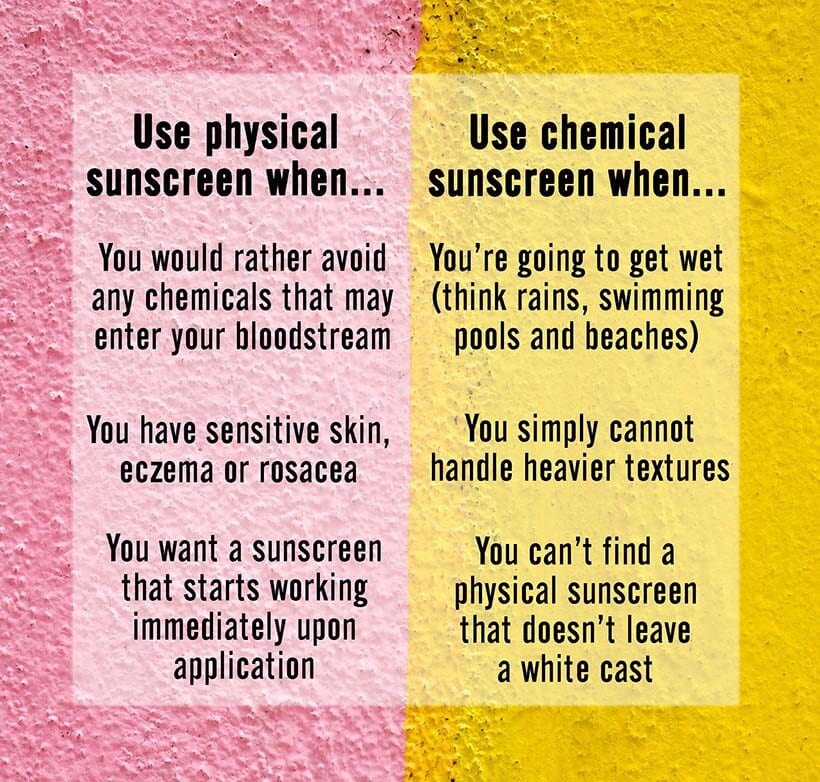Sun-kissed afternoons at the beach, picnics under the balmy sun, and those invigorating morning jogs: We all love the warm embrace of sunlight.
Yet, as we revel in these moments, the sun’s rays play havoc on our skin, sometimes leaving behind more than just a tan.
Enter sunscreen — our armor against these invisible foes. But not all sunscreens are crafted the same.
The beauty aisle divides them into two leading champions: Chemical vs mineral sunscreen. But which one should earn a spot in your daily routine? What’s the difference? Which ones work better? And are there any health risks?
Dive into this comprehensive face-off between chemical and mineral sunscreens. Let’s unearth their mysteries, debunking myths and spotlighting their strengths.
Chemical vs mineral sunscreen: What’s the difference?
There are two main types of sunscreens: Chemical sunscreen and mineral sunscreen.
Mineral sunscreens (also known as physical sunscreen or sunblock) contain mineral ingredients — usually zinc oxide or titanium dioxide. These create a physical barrier on the surface of the skin, which blocks and scatters UV radiation before it penetrates the skin.
Chemical sunscreens, on the other hand, work like a sponge by absorbing UV rays into the skin. Once absorbed, they change harmful UV rays to heat (a less harmful form of energy), then disperse them through the skin.
Formulations that contain both mineral and chemical ingredients are termed chemical sunscreens.
So, is it the same as organic vs inorganic sunscreens?
Sunscreens are one area where the term “organic” is not all it seems. And some unscrupulous brands play on this to mislead the consumers.
Here, the chemical sunscreens are referred to as “organic” by science — not because they are “natural” but because they contain carbon-carbon bonds.
Mineral sunscreens, on the other hand, are “inorganic” as they don’t contain any carbon bonds.
Chemical vs mineral sunscreen: Which is best?
This is not a one-size-fits-all situation. It depends on your skin type, lifestyle, and more. So, I will lay out all the information, and you have to decide which is the best sunscreen for YOU!
Chemical sunscreens may be absorbed into the bloodstream
For many, this may be the most significant factor when deciding between different types of sunscreen.
Because mineral sunscreen has physical blockers that sit on top of your skin, it does not enter your bloodstream.
Chemical formulas, on the other hand, can have certain ingredients absorbed into your bloodstream.
Is this a problem?
While the jury is still out on the health and safety concerns of these ingredients (not all chemicals are harmful!), I am wary about letting ones like oxybenzone or octinoxate near my body.
Recent studies indicate that we may be absorbing far more of these chemicals than was previously thought, further underlined by the fact that oxybenzone, which can be a hormone disruptor, has been detected in breast milk.
Similarly, the Environmental Working Group (EWG) has revealed that oxtinoxate (a chemical UV filter) has been found in users blood levels at 16 times above the proposed Food and Drug Administration (FDA) safety threshold.
However, as I said, science has not reached any unanimous conclusions, so this remains a matter of personal choice. I prefer to err on the side of caution, especially since hormonal disruptions have been my long-term issue.
The environmental impact
One thing, however, is non-debatable — and that’s enough to make me pick up a mineral sunscreen over a chemical one.
Oxybenzone is one of the leading causes of coral bleaching. It’s so harmful to marine life that Hawaii completely banned it in 2018!
If my decision between types of sunscreen impacts the environment, guess which way I will go?
The difference in application
Chemical sunscreen must go under any occlusive skincare, like oils or heavy moisturizers, as it needs to sink into the skin to prevent sun damage. It also takes about 20 minutes to start working (since the ingredients must be absorbed), so you can’t slap on and immediately step out of the door.
Physical sunscreen goes on top of your skincare, just under makeup. They start protecting you immediately, so there’s no waiting time required!
Chemical vs mineral sunscreen: Which one would suit my skin?
Both zinc oxide and titanium oxide are non-comedogenic (won’t clog pores), which makes physical sunscreen a good option if you have an acne-prone complexion.
On the other hand, chemical sunscreens may have multiple ingredients that can clog the pores, causing skin congestion.
However, physical formulas are usually thicker in texture and sit more heavily on the skin, which may not be the best bet for an oily complexion.
Chemical sunscreens have more flexibility in their formulation, allowing them to be lightweight and address several skin types. For instance, Supergoop Unseen Sunscreen SPF 40 is a chemical sunscreen that dries down matte and works brilliantly for oily skin.
Chemical sunscreens can trigger skin reactions
If you’ve ever felt your eyes sting after using sunscreen, it’s likely due to chemical filters. Chemical sunscreens are also more likely to trigger skin reactions like contact dermatitis and photosensitivity since multiple active ingredients have been combined for broad-spectrum coverage.
Another big one: People with rosacea-prone skin have increased chances of a flare-up with chemical sunscreens as they change UV rays into heat, which can escalate flushing.
Mineral-based sunscreen, on the other hand, has zinc oxide. This anti-irritant and skin protectant is commonly used in skincare lines for sensitive skin. Neutrogena’s Sheer Zinc Sunscreen Lotion SPF 50 even has the National Eczema Association’s stamp of approval.
Titanium dioxide (mineral sunscreen) comes in a close second. However, it could be a problem for those sensitive to mineral makeup.
Chemical vs mineral sunscreen: Which offers more protection?
Mineral sunscreens with zinc oxide are naturally broad-spectrum, protecting against UVA and UVB rays. Titanium dioxide also protects against UVB rays, but not the full spectrum of UVA rays (one of the reasons why I prefer zinc oxide).
However, both can rub or sweat off faster, requiring more frequent reapplication for mineral SPF.
Chemical sunscreens can also be broad spectrum, but you will have to check for the rating on the label specifically. You need to look for one that offers both UVA and UVB protection.
PS: Why is it essential to have a broad-spectrum sunscreen that protects against both UVA and UVB rays? That’s because both types of rays have harmful effects on the skin. UVA rays delve deep into the skin, causing premature aging, fine lines, wrinkles, and dark spots.
On the other hand, UVB rays mainly cause DNA damage in skin cells, leading to sunburns and a heightened risk of skin cancer. Additionally, UVB rays prompt melanin production, which results in tanning. Prolonged exposure to UVB can also leave the skin more vulnerable to various diseases and conditions.
Chemical sunscreens are more water-resistant
This is one place where chemical sunscreens score big. Physical sunscreen tends to sweat and rinse off quickly, not making it the best option for a day of swimming or water sports.
Chemical versions, however, work better here as they sink into the skin and won’t come off so quickly — giving them more longevity.
Mineral sunscreen can produce a white cast
Ah! The big one. This is why people opt out of using a mineral sunscreen: The mineral particles tend to create a white cast on the skin (which is particularly a problem for darker skin tones ).
Plus, zinc oxide and titanium dioxide are thicker and take some more effort to rub in.
Chemical sunscreens, on the other hand, have a lighter texture, are easier to rub into the skin, and don’t give off that ghosting effect.
Winner?
Not necessarily, since mineral formulas are constantly improving, becoming more lightweight and less whitening. One of the main advances is micronization, which means the particles have been made much smaller to minimize the white cast.
One of my favorites is the Drunk Elephant Umbra Sheer Physical Daily Defense SPF 30, with 20% zinc oxide, which gives a natural glow and broad-spectrum protection. La Roche-Posay Anthelios 50 Mineral Ultra Light Sunscreen Fluid is another physical sunscreen with a super-light texture and no white cast.
Several mineral-based sunscreens have moved even beyond micronization to nanoparticles (tiny particles of zinc oxide between one and 100 nanometres), which allow the formula to be texturally lighter and more transparent.
As for the debate about the safety of nanotechnology? Several bodies, including the Environmental Working Group, have shown that nanoparticles in sunscreen don’t penetrate the skin or cause damage.

FAQs: Chemical vs mineral sunscreen
Here are the most frequently asked questions about mineral and chemical sunscreens. Have one of your own? Drop it in the comments below, and we will get you the answers ASAP.
What is the difference between mineral and chemical sunscreen?
Chemical sunscreens contain organic (carbon-based) compounds that absorb the sun’s harmful rays and convert them into harmless heat, while mineral sunscreens use inorganic compounds, like zinc oxide or titanium dioxide, to block rays and reflect them away from the skin.
Is chemical sunscreen OK for acne-prone skin?
Some people with acne-prone skin might find chemical SPF irritating. It’s crucial to choose a product labeled “non-comedogenic” and monitor how your skin reacts.
What are the disadvantages of mineral sunscreen?
Mineral sunscreens can be thicker, may leave a white cast, and can be harder to blend into the skin. They can also sometimes feel greasier than their chemical counterparts.
Why do people prefer mineral sunscreen?
People might prefer mineral sunscreens because they are generally well-tolerated, even by sensitive skin types, offer immediate protection upon application, and are less likely to cause allergic reactions or irritations.
Does mineral sunscreen leave skin white?
Some mineral sunscreens can leave a white cast, especially those with a higher zinc oxide or titanium dioxide concentration. However, many modern formulations are designed to be more transparent or blendable, with a non-chalky finish.
How do I know if my sunscreen is chemical or physical?
Check the active ingredients on the label. If you see zinc oxide or titanium dioxide, it’s a mineral (physical) sunscreen. Ingredients like avobenzone, octocrylene, octinoxate, or oxybenzone indicate a chemical sunscreen.
Are chemical sunscreens safe for coral reefs?
Some chemical sunscreens contain ingredients like oxybenzone and octinoxate, which have been linked to coral reef damage. It’s best to choose reef-safe sunscreens when swimming in the ocean.
Are there any health concerns associated with chemical sunscreens?
Some concerns have been raised about certain chemicals, like oxybenzone, which may have hormone-disrupting properties. Always research and choose products from trusted brands.
What’s your take on chemical vs mineral sunscreen? Which one do you prefer?






Browntanned says
Wondering what are your thoughts on baby sunscrens for adults? I recently moved from chemical to physical ones too. I ordered blue lizard for my baby and I am hooked!
Amit says
I am of the opinion that chemical sunscreen are much better when it comes to protect skin . I use La prairie spf or La Mer reparative skintint spf 30. They not only protect skin from collagen damage but makes it luxuriously smooth , bright,silky and healthy . Physical sunscreen looks gross , smells cheap and gives acne and various skin ailments .
Cubanaq says
Scientifically, in chemistry any compound containing carbon is considered organic (versus inorganic commands that do not contain carbon). Used this way, the word organic is not meant to mean natural. There is no need for quotes here around the word organic. When companies use the word natural sunscreen, that is where you should use the quotes.
Gerry says
Picky picky, Fact is that providers of sunscreen or sun blockers that use terms like organic or natural are marketing a technicality and deliberately providing a false impression/narrative.
Gerry says
One of the components of the purchase cycle is cost. I’m using a Chemical brand and cost is a significant consideration. Are there any zinc based products that match the price points offered by the chemical versions?
harshita says
If we use chemical sunscreen it it sticky and skin losses it’s smoothness and nourishment and chemical sunscreens are so costly everyone cannot afford it and not giving us benefits or to our skin.
Gopika says
I am using a ‘Garnier SkinActive Vitamin C Brightening Day Cream’ and ‘VICHY Capital Soleil Solar Protective Water Hydrating SPF50’ in the morning, but still confused on the order in which I should apply them. Could you please help me out here? Thank you